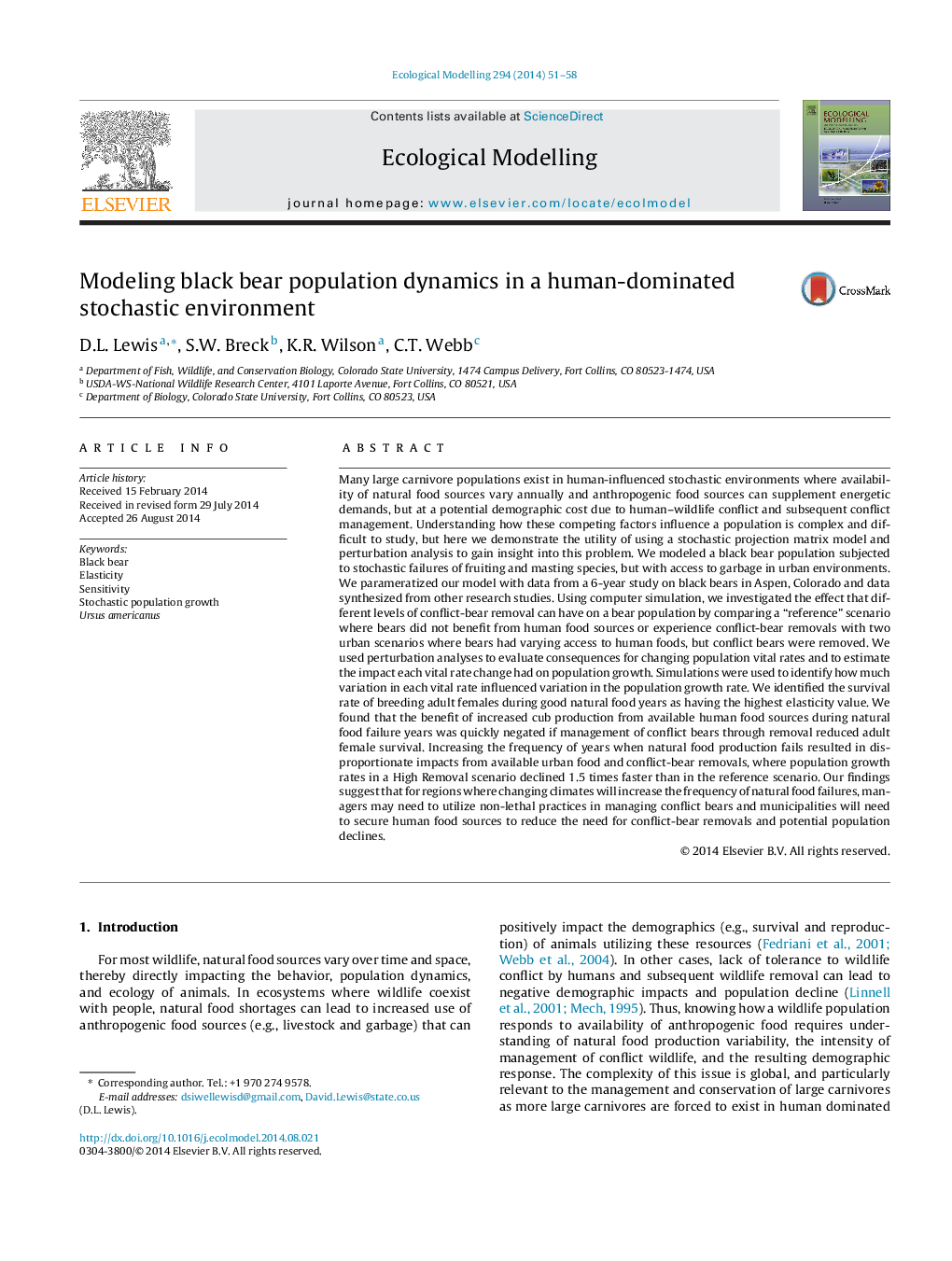| کد مقاله | کد نشریه | سال انتشار | مقاله انگلیسی | نسخه تمام متن |
|---|---|---|---|---|
| 6296697 | 1617452 | 2014 | 8 صفحه PDF | دانلود رایگان |
عنوان انگلیسی مقاله ISI
Modeling black bear population dynamics in a human-dominated stochastic environment
ترجمه فارسی عنوان
مدل سازی دینامیک جمعیت سیاه پوست در محدوده تصادفی غالب انسان
دانلود مقاله + سفارش ترجمه
دانلود مقاله ISI انگلیسی
رایگان برای ایرانیان
کلمات کلیدی
ترجمه چکیده
بسیاری از جمعیت های بزرگ گوشت خوار در محدودهای تصادفی تحت تاثیر قرار گیرنده انسان قرار دارند که در آن دسترسی به منابع طبیعی طبیعی سالانه متفاوت است و منابع غذایی انسانی می توانند مطالبات پرخطر را بپردازند، اما به دلیل هزینه های بالقوه جمعیت شناختی ناشی از درگیری های حیوانی و مدیریت پس از آن. درک اینکه چگونه این عوامل رقابتی بر جمعیت تأثیر می گذارد، پیچیده و دشوار است، اما در اینجا ما ابزار استفاده از مدل ماتریس طرح ریزی تصادفی و تجزیه و تحلیل اختلالات را برای درک این مشکل نشان می دهیم. ما یک جمعیت خرس سیاه و سفید را که در معرض شکستهای تصادفی از گونه های پرورش و پرورش است، اما با دسترسی به زباله در محیط های شهری، مدل سازی کردیم. ما مدل ما را با اطلاعاتی از یک مطالعه 6 ساله در مورد سیاه پوست در آسپن، کلرادو و داده های سنتز شده از تحقیقات دیگر تحقیق کردیم. با استفاده از شبیه سازی کامپیوتری، اثراتی را که سطوح مختلف از بین بردن تداخل را می توان بر روی یک جمعیت خرس با مقایسه یک مرجع؟ سناریو که خرس ها از منابع غذایی انسانی و یا تجربه برداشتن تحمل جنگ با دو سناریوی شهری که خرس ها دسترسی مجدد به غذاهای انسانی داشتند، استفاده نکردند، اما خرس های جنگی حذف شدند. ما از تجزیه و تحلیل مضرات برای ارزیابی عواقب برای تغییر نرخ های حیاتی جمعیت استفاده کردیم و برآورد تاثیر هر تغییر نرخ حیاتی بر رشد جمعیت. شبیه سازی ها برای تعیین اینکه تغییرات در هر یک از متغیرهای حیاتی در تغییر نرخ رشد جمعیت تاثیر گذار بود استفاده شد. ما در طول سالهای سالم غذای طبیعی به عنوان بالاترین میزان الاستیسیته، میزان بقا حیوانات بالغ را شناسایی کردیم. ما دریافتیم که سود حاصل از تولید زعفران از منابع غذای انسان موجود در طول سالهای شکست طبیعی غذا به سرعت از بین میرود اگر مداخلۀ درگیری از طریق حذف بروز بقای زن بالغ را کاهش دهد. افزایش فرکانس سالهای زمانی که تولید مواد غذایی طبیعی از دست رفته منجر به اثرات نامطلوب از مواد غذایی در دسترس شهری و تحرکات درگیری است، که در آن رشد جمعیت در یک سناریو حذف بسیار بالا 1.5 برابر سریعتر از سناریو مرجع. یافته های ما نشان می دهد که برای مناطقی که در حال تغییر شرایط آب و هوایی، فرکانس خرابی های غذایی طبیعی را افزایش می دهد، مدیران ممکن است نیاز به استفاده از شیوه های غیر مرگبار در مدیریت خرس های جنگنده داشته باشند و شهرداری ها نیاز به تامین منابع غذایی انسانی برای کاهش نیاز به برداشت از درگیری و جمعیت احتمالی کاهش می یابد.
موضوعات مرتبط
علوم زیستی و بیوفناوری
علوم کشاورزی و بیولوژیک
بوم شناسی، تکامل، رفتار و سامانه شناسی
چکیده انگلیسی
Many large carnivore populations exist in human-influenced stochastic environments where availability of natural food sources vary annually and anthropogenic food sources can supplement energetic demands, but at a potential demographic cost due to human-wildlife conflict and subsequent conflict management. Understanding how these competing factors influence a population is complex and difficult to study, but here we demonstrate the utility of using a stochastic projection matrix model and perturbation analysis to gain insight into this problem. We modeled a black bear population subjected to stochastic failures of fruiting and masting species, but with access to garbage in urban environments. We parameratized our model with data from a 6-year study on black bears in Aspen, Colorado and data synthesized from other research studies. Using computer simulation, we investigated the effect that different levels of conflict-bear removal can have on a bear population by comparing a “reference” scenario where bears did not benefit from human food sources or experience conflict-bear removals with two urban scenarios where bears had varying access to human foods, but conflict bears were removed. We used perturbation analyses to evaluate consequences for changing population vital rates and to estimate the impact each vital rate change had on population growth. Simulations were used to identify how much variation in each vital rate influenced variation in the population growth rate. We identified the survival rate of breeding adult females during good natural food years as having the highest elasticity value. We found that the benefit of increased cub production from available human food sources during natural food failure years was quickly negated if management of conflict bears through removal reduced adult female survival. Increasing the frequency of years when natural food production fails resulted in disproportionate impacts from available urban food and conflict-bear removals, where population growth rates in a High Removal scenario declined 1.5 times faster than in the reference scenario. Our findings suggest that for regions where changing climates will increase the frequency of natural food failures, managers may need to utilize non-lethal practices in managing conflict bears and municipalities will need to secure human food sources to reduce the need for conflict-bear removals and potential population declines.
ناشر
Database: Elsevier - ScienceDirect (ساینس دایرکت)
Journal: Ecological Modelling - Volume 294, 24 December 2014, Pages 51-58
Journal: Ecological Modelling - Volume 294, 24 December 2014, Pages 51-58
نویسندگان
D.L. Lewis, S.W. Breck, K.R. Wilson, C.T. Webb,
